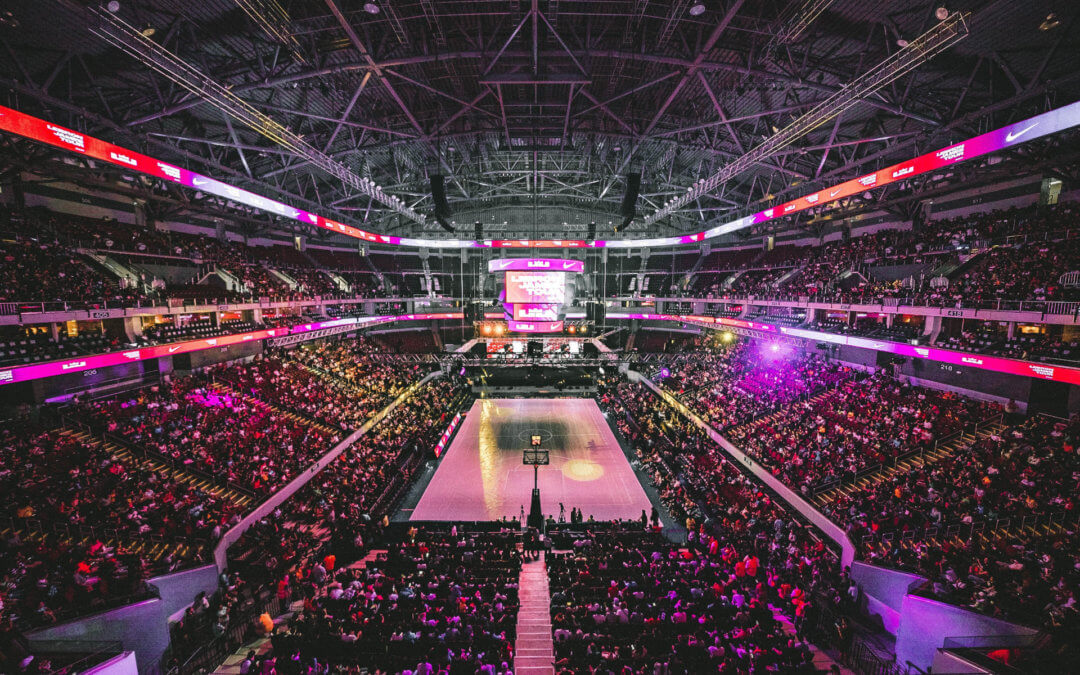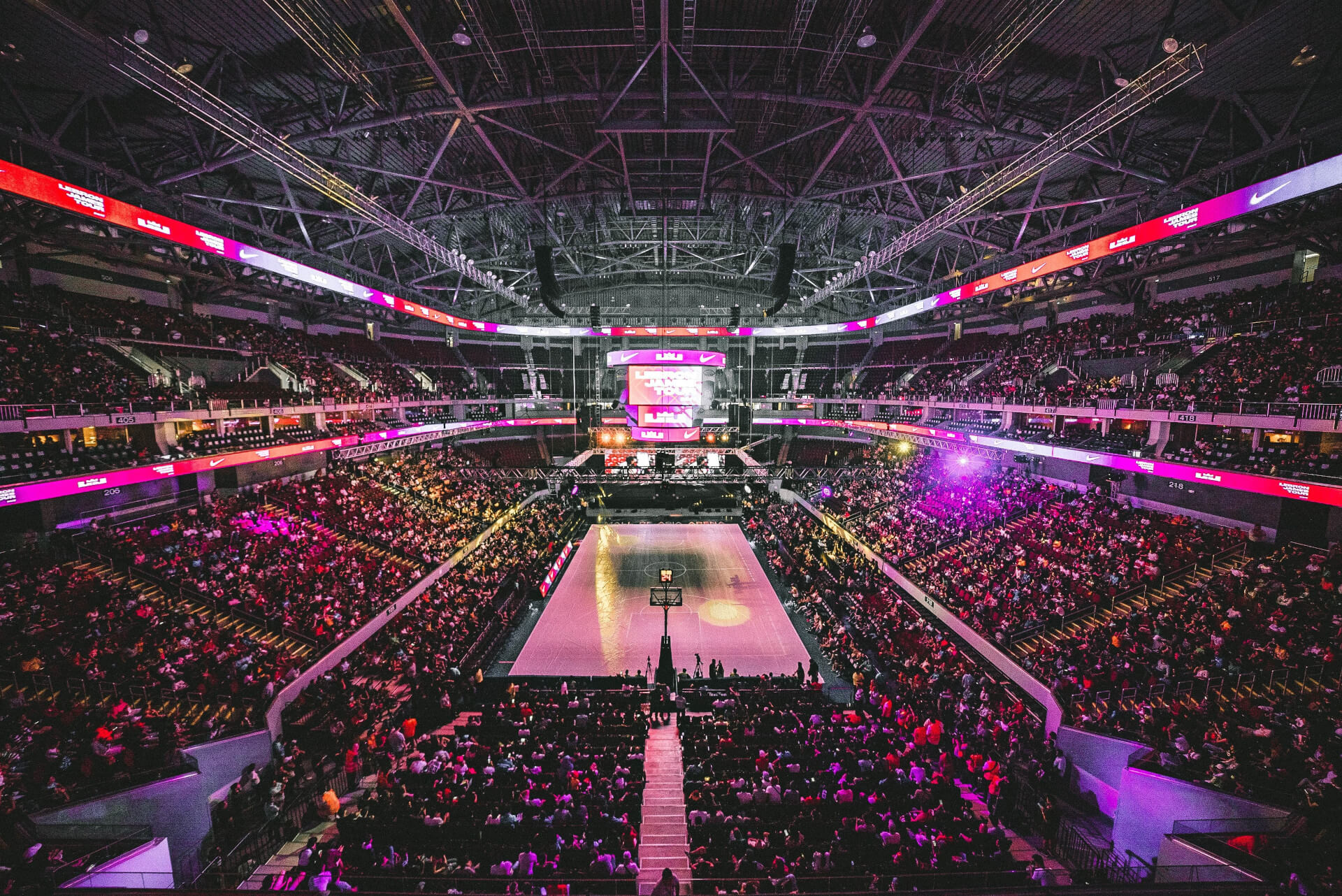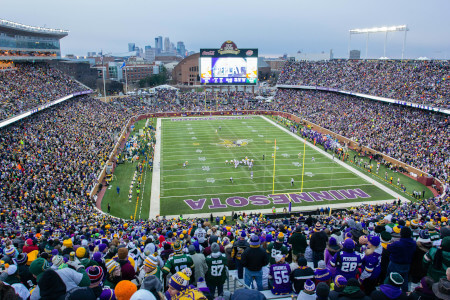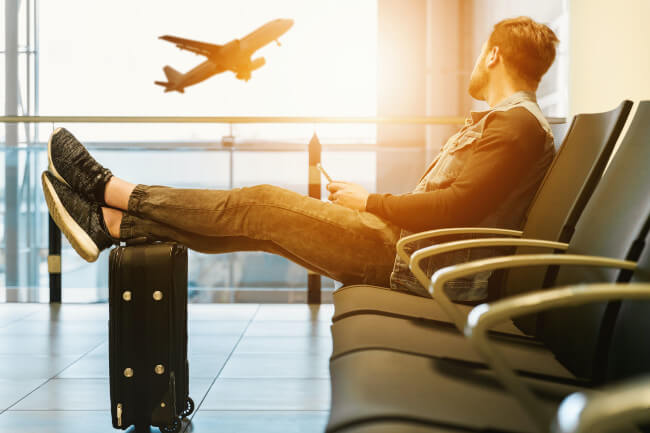Accessibility will have a new face at the Olympic and Paralympic Village in Greater Paris.

The Guidelines for Stadium Accessibility: Offering People with Disabilities a Good Experience

The Guidelines for Stadium Accessibility: Offering People with Disabilities a Good Experience
Tous les fans de football américain seront d’accord : regarder un match à la télévision n’est rien comparé à aller au stade encourager son équipe favorite. Écouter The Boss chez soi n’atteindra jamais la sensation ressentie par ceux qui ont eu la chance de le voir jouer dans l’ancien Giants Stadium, devenu MetLife Stadium, pour sa tournée « Born in the USA », qui a fait de lui une légende du rock. On vient au stade pour profiter de l’ambiance, pour crier et chanter, pour se retrouver, pour partager un bon moment…
Pour les personnes en situation de handicap, se rendre au stade peut s’avérer un véritable défi en raison de l’accessibilité. Dans une enceinte pouvant accueillir plus de 100 000 visiteurs, quelle place leur est accordée ? Comment rendre accessibles des lieux aussi vastes et complexes que les stades ? Quelles mesures sont mises en œuvre pour accueillir et accompagner les personnes en situation de handicap ? Sont-elles adaptées à tous les types de handicap ?
Est-ce un choix idéal pour les stades américains ? Examinons leur score global en matière d’accessibilité !
Mesures favorisant l’accessibilité des stades
Les stades sont des lieux tellement vastes, avec une foule constante et omniprésente, qu’il serait facile de penser que les rendre accessibles relève de l’utopie ! Pourtant, différentes mesures sont déjà mises en œuvre, ou sont en cours de mise en œuvre, pour permettre à tous les visiteurs d’être accueillis et de se sentir à l’aise, quel que soit leur profil.
Conformément à l’ Americans with Disabilities Act (ADA) de 1990, qui interdit toute discrimination à l’égard des personnes handicapées dans tous les domaines de la vie publique, les lieux publics doivent garantir aux personnes handicapées le même accès et les mêmes services qu’à tout autre visiteur. Pour les stades, cela implique l’application de mesures visant à garantir et à promouvoir l’accessibilité pour tous, quel que soit le handicap, telles que :
⊗ Places de stationnement PMR ;
⊗ Comptoirs abaissés aux concessions et aux stands de marchandises ;
⊗ Zones d’assise pour fauteuils roulants ;
⊗ Accompagnateurs en fauteuil roulant;
⊗ Dispositifs d’écoute assistée pour les personnes malentendantes ;
⊗ Boucles d’induction audio ;
⊗ Balises sonores situées à différents points d’intérêt stratégiques (entrées, sorties…) pour les personnes malvoyantes ;
⊗ Ascenseurs, escaliers mécaniques et rampes;
⊗ Nez de marche antidérapants à contraste visuel ;
⊗ Chemins de guidage ;
⊗ Pictogrammes universels pour les personnes ayant une déficience intellectuelle ;
⊗ Espaces dédiés aux animaux d’assistance ;
⊗ Sous-titrage pour les annonces spéciales et/ou les discours publics destinés aux malentendants ;
⊗ Description audio pour les malvoyants ;
⊗ Téléphones publics accessibles ;
⊗ Toilettes accessibles.
Plus d’informations sur les sièges accessibles tels qu’indiqués par l’ADA :
⊗ Au moins 1 % des sièges doivent être des places pour fauteuils roulants ;
⊗ Des sièges accessibles doivent être disponibles dans chaque catégorie de sièges et à différents prix de billets ;
⊗ Un siège d’accompagnement doit être situé à côté du siège du fauteuil roulant ;
⊗ Des sièges accessibles doivent être situés dans toutes les zones, y compris les loges et les zones spécialisées ;
⊗ Les sièges accessibles doivent se trouver sur un parcours accessible permettant l’accès depuis les zones de stationnement et de transport et reliant tous les services fournis (concessions, restaurants, toilettes…) ;
⊗ Tous les sièges pour fauteuils roulants doivent offrir une ligne de vue sur les spectateurs debout ;
⊗ 1 % de tous les sièges fixes doivent être des sièges côté couloir sans accoudoir ou avec un accoudoir amovible ou rabattable pour accueillir les personnes à mobilité réduite.
De nombreux stades proposent déjà ce type de mesures et de solutions faciles à mettre en œuvre, comme le Madison Square Garden . Le Garden, aussi connu comme l’arène la plus célèbre du monde, accueille aussi bien des événements sportifs que des concerts. Ce lieu illustre parfaitement ce que l’accessibilité peut et doit être. Le Garden va même plus loin en proposant des services d’interprétation aux visiteurs. Les personnes malentendantes peuvent ainsi comprendre parfaitement le déroulement du match grâce à un interprète en langue des signes. Les personnes sensibles aux stroboscopes ou aux lumières clignotantes pendant un spectacle peuvent être prévenues à l’avance, sur demande, afin d’être informées des difficultés potentielles. Être informées à l’avance leur permet de se sentir en sécurité et de garder le contrôle. Elles peuvent ainsi profiter du spectacle comme tout le monde.
Le Garden n’est pas le seul lieu à penser au bien-être de chacun, quel que soit son profil. En effet, l’ US Bank Stadium de Chicago, domicile des Vikings, a créé une salle sensorielle , un lieu calme et apaisant pour ceux qui ont besoin de silence lorsque les activités sportives deviennent trop bruyantes et intenses. Les personnes atteintes du syndrome de Down, du spectre autistique ou de démence peuvent ainsi y trouver un refuge. La salle est équipée de casques antibruit, de bouchons d’oreilles, de jouets sensoriels et d’un éclairage tamisé… Une initiative innovante qui favorise l’inclusion des personnes ayant des besoins sensoriels ! Un stade qui ouvre la voie à une meilleure accessibilité !
Le site web de l’US Bank Stadium propose des plans de l’extérieur et de l’intérieur du stade. Les visiteurs peuvent ainsi préparer leur excursion et obtenir toutes les informations nécessaires à l’avance pour éviter tout stress. Ils peuvent même télécharger les plans sur leur smartphone. Sachant que 84 % des personnes handicapées utilisent un smartphone pour gagner en autonomie au quotidien, il est logique que les smartphones deviennent de plus en plus indispensables.
L’utilisation d’une application d’orientation intérieure comme Evelity qui guide les personnes handicapées étape par étape pourrait être extrêmement utile dans un lieu aussi complexe, car l’application peut non seulement aider les utilisateurs à trouver leurs repères, mais peut également localiser les entrées et les sorties et d’autres points de repère dans le lieu.
De plus, Evelity s’adapte au profil de l’utilisateur et à ses capacités pour mieux répondre à ses besoins.
Comment l’accessibilité des stades peut-elle garantir une bonne expérience aux personnes handicapées ?
Comme nous l’avons vu, l’objectif d’un stade accessible est de permettre à tous ses visiteurs de partager la même expérience : accéder facilement à leur place, avoir une bonne visibilité du match… Mais aussi participer activement aux festivités : chanter l’hymne de l’équipe, crier sa joie lorsque son équipe favorite marque et ainsi profiter pleinement de l’ambiance que le stade a à offrir.
Il est essentiel que les personnes handicapées se sentent à l’aise dans un lieu fréquenté et bondé. Certaines préfèrent venir au stade avec un accompagnateur qui peut les aider si nécessaire. Celles qui viennent seules peuvent compter sur le personnel ou les accompagnateurs du stade pour les guider et les assister. L’accessibilité des stades va bien au-delà de la simple mise en place d’équipements accessibles.
Les accompagnateurs doivent être capables de répondre aux besoins des supporters, quel que soit leur handicap. Les accueillir avec le sourire, être disponible, savoir anticiper leurs besoins et leurs obstacles potentiels et faire preuve d’empathie sont autant de qualités essentielles. L’ensemble du personnel du stade (accompagnateurs, vendeurs, agents de sécurité), interne et externe, doit être bien formé à tous les aspects. Grâce à un partenariat avec Fraser Pediatric Therapy, deux spécialistes du comportement agréés prennent en charge les visiteurs dans la salle sensorielle de l’US Bank Stadium. Lors de chaque match à domicile, les personnes présentant un handicap sensoriel peuvent solliciter leur aide pour se détendre.
Le stade Bank of America de Charlotte, en Caroline du Nord, qui abrite les Panthers de Caroline, dispose de cabines de relations avec les clients situées à chaque entrée principale pour répondre à toutes les questions que les personnes handicapées peuvent avoir sur le stade ou les transports en commun et les aider en conséquence.
Avoir un personnel bien formé permet aux visiteurs de se sentir en sécurité et à l’aise, leur assurant ainsi de profiter pleinement du jeu. Ils partagent la même expérience que tous les autres visiteurs.
Entrer et sortir du stade
Se rendre au stade n’est pas toujours facile en raison de l’affluence et des embouteillages qui en découlent. Est-il plus pratique de partir tôt pour trouver une place de parking ? L’Ohio Stadium de Colombus, dans l’Ohio, met à disposition un plan indiquant aux visiteurs comment rejoindre leur parking accessible depuis différentes directions, ainsi que le trajet des navettes accessibles entre le parking et les entrées du stade. D’autres stades permettent aux visiteurs de réserver leur place de parking à l’avance afin de ne pas avoir à se soucier de trouver une place à leur arrivée. Pour ceux qui ne disposent pas de véhicule, les transports en commun sont toujours une option, mais c’est plus simple avec un métro accessible .
La gare Penn Station mène directement au Madison Square Garden. C’est un carrefour majeur car il relie les trains interurbains et de banlieue de New York. Lorsqu’elles utilisent les transports en commun, les personnes handicapées doivent toujours faire attention à leur environnement. Parfois, même l’achat d’un billet peut s’avérer difficile. Être accompagnées peut soulager leur stress et les rassurer. C’est pourquoi un personnel efficace et bien formé est essentiel pour répondre à leurs questions.
Un stade inclusif et accessible est possible grâce à différentes mesures faciles à mettre en œuvre, à l’intérieur comme à l’extérieur du stade. Tous les supporters, en situation de handicap ou non, peuvent profiter de leur expérience et partager un moment convivial. L’accessibilité des stades doit constamment évoluer pour répondre aux besoins des personnes en situation de handicap.
Mis à jour le 27 décembre 2021 / Publié le 28 septembre 2020
media

The goal of having an accessible stadium is to enable all its visitors to share the same experience: easily accessing their seat, having a good visibility of the game…
writer

Carole Martinez
Content Manager
stay updated
Get the latest news about accessibility and the Smart City.
other articles for you

Open Data Is Key to Fostering Universal Accessibility
Open data represents an opportunity for cities to reach universal accessibility. It shows the missing links of the mobility chain.
Our Audio Beacons Guide the Blind and Visually Impaired at the Helsinki Subway
The Helsinky subway improved their audio signage system by installing on demand and remotely activated audio beacons.
7 Good Reasons to Install Audio Beacons at Your Public Transport Network
Audio beacons are an efficient way to provide more autonomy to blind and visually impaired people. They can easily use public transport.

Will Remote Activation Become the Norm for Accessible Pedestrian Signals?
More and more cities like New York have been exploring remote activation to trigger accessible pedestrian signals.
share our article!
more articles

Disability Statistics in the US: Looking Beyond Figures for an Accessible and Inclusive Society
Disability Statistics in the US: Looking Beyond Figures for an Accessible and Inclusive Society Around 61 million adults in the United States live with a disability. Diving into disability statistics in the US will help us know exactly who is concerned and what...
Our Audio Beacons Guide the Blind and Visually Impaired at the Helsinki Subway
Our Audio Beacons Guide the Blind and Visually Impaired at the Helsinki SubwayOur audio beacons equip the new line of the Helsinki subway in Finland. They help blind and visually impaired people locate the points of interest of a station. For users with visual...

Will Remote Activation Become the Norm for Accessible Pedestrian Signals?
Will Remote Activation Become the Norm for Accessible Pedestrian Signals?Without pushbutton, there are no accessible pedestrian signals. That’s how APS work in the U.S. But more and more cities have been exploring remote activation like New York City. The Department...

Hearing Impaired People: a Multitude of Profiles for Different Needs
Hearing Impaired People: a Multitude of Profiles for Different Needs Did you know that hearing impaired people have several profiles and that the way they identify themselves is important? You may be familiar with deaf and hard of hearing people but for each of...
NEVER miss the latest news about the Smart City.
Sign up now for our newsletter.
Unsubscribe in one click. The information collected is confidential and kept safe.
powered by okeenea
The French leading company
on the accessibility market.
For more than 25 years, we have been developing architectural access solutions for buildings and streets. Everyday, we rethink today’s cities to transform them in smart cities accessible to everyone.
By creating solutions ever more tailored to the needs of people with disabilities, we push the limits, constantly improve the urban life and make the cities more enjoyable for the growing majority.






Recent Comments